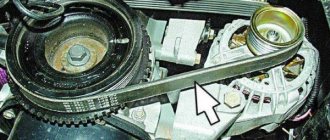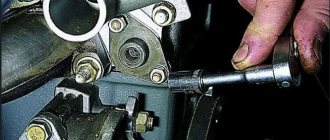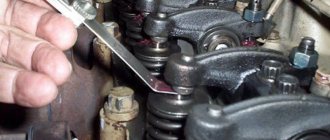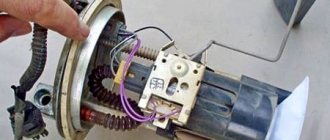01/26/2022 12 192 VAZ 2101
Author: Ivan Baranov
The timing chain plays an important role in the operation of the gas distribution mechanism. Over time, it stretches and requires tension, since the quality of the engine depends on it. Therefore, you need to know when to check the tension and how to tension the chain on a VAZ 2101. This topic is covered in an article and a video that demonstrates the process of checking and tensioning the chain drive.
[Hide]
Signs of a poorly adjusted chain
When they talk about a poorly adjusted chain, they usually mean a loose and sagging chain. Because a highly tensioned chain does not show any signs of breakage. She's just bursting. Here are the main signs that the timing chain has become loose:
- after starting the engine, a loud grinding and knocking noise is heard from under the hood, the frequency of which increases as the crankshaft speed increases. This occurs due to the fact that the slack chain continuously hits the damper and the tension shoe;
- the car reacts poorly to pressing the gas pedal: the engine begins to increase speed only one or two seconds after pressing. This is due to the fact that due to a sagging chain, the synchronism of rotation of the timing shaft and the crankshaft is disrupted;
- There are power failures in engine operation. Moreover, they can occur both when accelerating and when the engine is idling. Due to the desynchronization of the shafts, which was mentioned above, the operation of the cylinders in the engine is also disrupted. In this case, one cylinder either does not work at all, or works, but not at full strength;
- increase in fuel consumption. If the cylinder block is not working properly, this cannot but affect fuel consumption. It can increase by a third, and in especially severe cases - double.
If the driver notices one or more of the above signs, this only means one thing: it’s time to remove the timing chain and check for wear. If it turns out to be very worn, it will have to be replaced. If the wear is minor, the chain can simply be tightened slightly.
Typical chain tensioner defects
Such malfunctions include:
- A collet-type clamp is not able to fix the product rod, which interferes with adjustment work on the correct tension of the chain drive.
- Wear of the main spring element (looks like this: the spring element is deformed in one plane, which becomes noticeable after dismantling the chain tensioner, which shines on one side).
- Damper spring failure.
- Limit wear of the product rod at the point where the collet-type clamp is attached.
- Defects in threaded connections on the installation fasteners (studs) of the product.
How to Stretch a Chain on a VAZ 2101 Video
Tension of the tension circuit on a VAZ 2101 car in artisanal conditions
The timing chain is important in the timing mechanism. Over time, it stretches and requires tension because it affects the quality of the engine. Therefore, it is necessary to know when to check the voltage and how to tighten the chain on a VAZ 2101. This topic is discussed in the article and video, which show the process of checking and tensioning the chain drive.
When is stretching needed?
Chain tension is required in the following cases:
- after engine repair;
- after replacing the product;
- when stretched after long-term use.
Timing of VAZ 2101
In the first 2 cases, it is clear that a voltage check is required, since the circuit
Taken in different ways. Replacement. Additionally, it should also be checked to ensure that the alignment markings are the same. These marks are located on the crankshaft and camshaft. Find the need for stretching usually to the sounds of a running motor. If the tension is weak, then during its operation you can hear extraneous noise where the chain drive is located. With all these parts, time wears out faster
Therefore, when checking the tension, it is necessary to pay attention to the condition of the damper and trunk
Timing belt
How to tighten a chain on a VAZ 2101 video.
If the link tension is weak, sliding vibrations between several teeth are possible, and then the valve synchronization will be disrupted. The car can stop here, but not start, the speed will fluctuate. Use a flathead screwdriver to check. It must be locked and pressed against the chain using a lever. It should not bend and stretch like an arrow. Do not apply excessive force to the drive, although the part is made of iron, it is subject to deformation.
At the bottom of the video, the VAZ car is considered 2101, where you hear an accident with the engine running. Detailed information is provided on how to check the condition of the damper, boot and how to tension.
pull a chain correctly
cars with VAZ
Traditional series. groups.
Step by step guide
Before proceeding with defect repair, ensure that the customer remains free of any mechanical defects from the temporary components. To do this, it is necessary to remove the protective cover of the drive and conduct a visual inspection of the parts: sprockets, damper, tensioner and trunk. If deficiencies are identified, they should be replaced.
from these devices.
tools
Before you begin, you need to prepare the necessary tools:
- keys for "13" and "38";
- flat screwdriver;
- pliers.
To operate, the car must be installed on a convenient platform, and supports are placed under the wheels to prevent it from rolling. The gear shift lever must be set to neutral.
VAZ Engine Division 2101
Stages
- First you need to find the tensioner, it is located under the injectors next to the pump. The key “13” should release the tensioner. As the chain loosens, the trunk should break.
- Then take a 38" wrench and screw it onto the crankshaft pulley nut. Then turn the crankshaft several turns clockwise.
- Rotate the shaft until the marks on the camshaft sprocket on the camshaft bearing housing line up. In this case, the spring located inside the tensioner and acting on the barrel will automatically perform the necessary stretching.
- It is better to check the tension using a screwdriver. If our client remains normal, we go back to the tensioner and tighten his head with a wrench.
Checking tension with a screwdriver
Pull the chain drive, start the engine and check its operation. It should work without noise from outside. If interference remains after the tension, you prefer the cause to be a tranquilizer. Then you need to check its serviceability if you want to replace it
. This may not work to raise the chain drive the first time, so this procedure will have to be repeated several times. During the procedure, the marks must match to ensure that the gas distribution phase is not disrupted.
This operation must be performed every time after any repair work. In addition, after marking it is necessary to carry out a preventive check. 10 thousand kilometers. If you learn to check and strain yourself, this will allow you to extend its service life and save on car service costs.
This video demonstrates how to pull a chain in a classic VAZ.
When is stretching necessary?
Chain tensioning is required in the following cases:
- after engine repair;
- after replacing the product;
- when stretched after prolonged use.
Timing belt VAZ 2101
In the first two cases, it is clear that checking the tension is necessary, since the chain was removed or replaced. In addition, you should also check that the alignment marks match. These marks are located on the crankshaft and camshaft. You can determine the need for tension by the sounds of the engine running. If the tension is weak, then during its operation extraneous noises are heard in the place where the chain drive is located. At the same time, timing parts wear out faster. Therefore, when checking the tension, it is necessary to pay attention to the condition of the damper and the shoe.
Timing tensioner shoe
If the tension is weak, the links can jump several teeth, then the valve timing will be disrupted. In this case, the car may stall, not start, and the speed will fluctuate. You can use a flathead screwdriver to check. It needs to be inserted and, using as a lever, pressed on the chain. It should not bend and be stretched like an arrow. Do not put too much pressure on the drive, although the part is metal, it is subject to deformation.
The video below looks at a VAZ 2101 car, in which a clattering sound is heard when the engine is running. It shows in detail how to check the condition of the damper, the shoe, and how to carry out tension.
Adjustment or how to set timing marks on a VAZ 2106 yourself
Decoding notes
Without pre-basing the pistons and valves, installing the timing chain on the VAZ 2106 according to the marks is impossible. Therefore, the significance of the marks is not at all conditionally decorative. The signs give an understanding of the position of parts inside the motor:
- The mark on the KV pulley, which coincides with the long line on the front cover, means that the pistons of cylinders 1 and 4 have reached TDC.
- The mark on the RV sprocket, combined with the tide on the bed, informs about the closed valves in cylinder 4 - this is where the compression stroke occurs.
When the marks coincide, the ignition distributor slider is turned towards cylinder 4, and the valves of the latter are closed. By analogy with setting the clutch on a “classic”, the unambiguity of the relative position of the crankshaft and camshaft serves as the basis for adjusting the clearances in the valve mechanism and the ignition setting procedure.
How to restore tag matches
When the chain is pulled out, the marks will go away. The main difficulty is to return them to a position of mutual coincidence. This work is combined with dismantling the old chain. However, there is no need to rush to remove it - misalignment of all factory markers is fraught with danger.
The base is the position of the crankshaft at which the pulley mark coincides with the long line on the front cover. In this case, the drilling hole for the camshaft star should be closer to the high tide. This must be achieved first. It is worth remembering that the transmission is made with a 2:1 ratio - two revolutions of the crankshaft correspond to one revolution of the camshaft.
- Remove the camshaft sprocket, remove all other gears and the chain stopper.
- Take out the chain.
- Put the camshaft sprocket back (without the chain), tighten the bolt, tighten it, securing the part by the teeth with a screwdriver.
- Rotate the camshaft until the marks on the sprocket and bed coincide.
- After fixing the sprocket with a screwdriver, unscrew the bolt and remove it.
- Install a new chain, sprockets, tensioner shoe and damper plate.
Unnecessary fears when dismantling the RV sprocket are not appropriate. The shaft design includes a pin. In addition to transmitting torque, it serves as a fixator of a certain position.
How to put on a chain
Installation of a new chain begins with its attachment to a new crankshaft sprocket. Next, the damper, tensioner shoe, and limiter are mounted. The chain is passed through the drive shaft gear and secured along the way. Afterwards it is mounted on the camshaft sprocket, and its position is adjusted according to the cycle:
- Put it on the shaft.
- Look at the relative position of the drill bit and boss.
- Take off.
- Move one tooth in the desired direction.
The final procedure is to tighten the chain, during which the tensioner is twisted all the way with good force. After rotating the HF key, the final check of the coincidence of the signs is carried out.
VAZ 2105 - replacing the camshaft drive chain
We replace the camshaft drive chain on a VAZ 2105 and other models from the “classic” series if it is not possible to restore the required degree of tension using the usual method using a tensioner. The verdict is clear - the chain has stretched beyond the permissible limits and needs to be replaced. The dismantling work on all types of classic engines is identical, so let’s look at the replacement process using the example of the most popular engine of the VAZ 2103 family. On an injection engine, the sequence of work is also identical with the only difference being that you will have to disconnect the block with wires from the crankshaft position sensor.
To carry out repair work, we prepare a standard set of tools, namely wrenches of different calibers from ten to seventeen, screwdrivers, pliers, etc. There is no need to drive the car into a pit for repairs. If you have everything you need, we begin the process, the sequence of actions of which is as follows:
- We remove the valve cover and, turning the crankshaft as it rotates, align the marks on the camshaft sprocket with the mark on the camshaft bearing cover housing.
- Next, using a flat-head screwdriver and a hammer, bend the tabs of the lock washer on the camshaft sprocket mounting bolt.
- Now we need to loosen the bolt. To do this, stop the car with the parking brake and engage any gear. We just loosen the bolt without completely unscrewing it.
- We remove the VAZ 2105 chain guide and the tensioner shoe. To remove all this equipment, we need to remove the front cover of the camshaft chain, unscrewing all the bolts securing it around the perimeter. A sealing gasket is installed between the cover and the block, which, regardless of its condition, must be replaced with a new one during subsequent assembly.
- Loosen and completely unscrew the chain stop pin.
- Next, we need to straighten the petals of the auxiliary sprocket lock washer. We use a flathead screwdriver with a long shaft and a hammer.
Unscrew the bolt securing the auxiliary device sprocket
To prevent the sprocket from turning, carefully fix it with a flat screwdriver by inserting the rod between the teeth and resting the screwdriver against the cylinder block. After the bolt is unscrewed, use a small mounting blade to pull the sprocket off the shaft.
- We completely unscrew the bolt securing the camshaft sprocket and, carefully lifting the chain, remove the sprocket from the shaft.
- We lower the chain down and remove it from the crankshaft sprocket, and install the camshaft sprocket itself in place, aligning the marks as they were.
After removing the old chain, you can begin installing the new one. The new chain is put on the auxiliary sprocket, after which the sprocket itself is installed in its place and secured with a fastening bolt (do not forget to install a new lock washer).
Prepare a long metal hook, use it to pick up the chain from above and pull it towards the camshaft sprocket. Place the chain on the sprocket. Secure the sprocket and bend the tabs of the lock washer.
All. At this point, the process of replacing the old camshaft drive chain of the VAZ 2105 can be considered complete. At the final stage, install the tensioner, tensioner shoe and chain guide and stop pin in the reverse order of removal. Check the tightness of all bolts securing system elements. Turn off the speed and parking brake and turn the crankshaft a few revolutions and check the alignment of the marks on the sprocket and the camshaft bearing cap. If the marks do not match, then it is necessary to throw the chain onto the link either forward or backward. If the installation was successful and the marks match, tighten the tensioner cap nut. Check and adjust the ignition if necessary. This completes the repair work.
About chain tension on the VAZ-2107
One of the most important components of every car is the gas distribution mechanism. The proper operation of this unit affects the operation of the entire motor. The drive mechanism of the timing system on the VAZ 2107 is a chain. If it sags too much, it can jump onto one of the sprockets. If it is displaced by at least one tooth, failures in the operation of the motor occur, as well as destabilization of the speed. To avoid sagging of the chain, it is necessary to periodically tension it, and if certain signs occur, replace it.
How often does tension need to be applied?
During operation, the chain is subjected to heavy loads, so its service life is 60-80 thousand km. Adjustment should be carried out every 15 thousand km, but if the driver discovers earlier that something has begun to rattle when the engine is running, then it should be diagnosed. Before tensioning, you need to check its serviceability.
It is also necessary to check the tension in the case when the timing belt repair on the VAZ 2107 was carried out or in the case when, after tensioning, knocking of the product is still observed. The knock, or more precisely, the rustling of the chain, will not be difficult to distinguish even for an inexperienced driver. This rustling noise can be clearly heard if you lift the hood and listen to the engine at idle speed. If you add gas, the rustling disappears, which actually means that it’s time to tighten the timing chain. For this, a timing chain tensioner is used, which come in different types: automatic and mechanical.
Step-by-step instructions for stretching
Now let’s pay attention to the question of how to properly tension the timing chain on a VAZ 2107. Initially, it is worth noting that the timing mechanism on VAZ 2107 cars with an injector and carburetor fuel supply system are absolutely identical. The tension on the VAZ 2107 is performed in the following sequence:
The tension on the VAZ 2107 is performed in the following sequence:
- The car is placed on a flat surface, the “neutral” is turned on, and the wheels are fixed.
- The tensioner cap is loosened (using a 13 key), which is located near the pump.
- The crankshaft is turned 2 turns clockwise, for which a special key is used (pictured).
- After this, the tensioner is tightened to failure.
- Next, we start the engine and listen to see if the clanging remains.
- If it disappears, then the chain is tight. If there is any left, we recommend repeating the procedure from point No. 2.
If the actions taken are not successful and the noise remains, you will have to resort to a visual inspection of the timing mechanism, and for this you will have to disassemble the engine.
Tension check
The VAZ 2107 chain is located in the front part of the engine. It is not visible, since it is covered by the cylinder head cover and the block itself. Before you start disassembling the VAZ 2107 engine, you need to understand the features of visual inspection and checking its tension. It is rational to check the chain tension only in cases where regular tensioning does not help solve the problem.
How to tension the camshaft drive chain of a VAZ-2101-2107.
To visually check the tension of the VAZ-2107 timing chain, you must first remove the air filter housing, then the cylinder head cover. To do this, you will need a “10” wrench, with which you need to unscrew 8 fastening nuts.
After removing the valve covers, access to the upper part of the product becomes available. Here you need to inspect the tensioner shoe and damper for integrity, and then check the chain mechanism with your hands, and if that doesn’t work, you can use a pry bar or a large screwdriver.
The mount must be installed so that it stands between the chain mechanism and the block body. As a result, we get a lever that is used to check the chain tension on a VAZ 2107 car. If it bends easily, then its tension needs to be adjusted or replaced. The ideal tension is one at which the product does not bend and is taut like a string.
https://youtube.com/watch?v=L27fdFKEj-U
Repair of VAZ 2107 tensioners is not carried out, so the product will have to be replaced with a new one. Replacement is rarely required, but the ANC “Pilot” automatic tensioner is best suited for this. After installing it, you will forget about the noise and clanging of the engine for a long time. But if you already have an automatic tensioner installed, and the engine is knocking or the chain is making noise, then there is no point in making adjustments. You will have to immediately disassemble and replace the timing mechanism parts.
Main Causes of Circuit Failure
As the engine speeds up, the chain begins to rattle. In this case, the metallic ringing goes away as the speed decreases. A stretched timing chain contributes to a gradual shift in the valve timing, which leads to engine malfunctions.
All owners of cars of this brand should know how to tighten a chain on a VAZ 2107. This work is performed using a “13” wrench and a hammer. The chain is adjusted as follows.
- The tensioner is discharged. When performing this procedure, the shoe should snap off. If this does not happen, it means that the timing chain tensioner plunger is stuck. The problem is eliminated by tapping the unit body with a hammer.
- Using a key set to “13”, the cap nut is unscrewed.
- Using a special crankshaft wrench, the pulley is turned a couple of turns.
- The crankshaft stops at the moment of maximum rotational resistance. In this position, tension is applied.
- While holding the crankshaft from turning in the opposite direction, tighten the cap nut.
- The cylinder head cover is being installed.
In some cases, such tension is ineffective. Experienced auto mechanics know how to tighten the VAZ 2107 injector chain. To do this, you will need the following tools: 8 and 10 sockets, pliers and a ratchet with a handle. The valve cover is unscrewed and dismantled, thus providing access to the camshaft sprocket. The chain tension is checked manually.
The next step is to turn the crankshaft of the VAZ 2107 injector several turns. This work is carried out by turning on the starter for a few seconds or using a wrench that is placed on the ratchet.
A timing belt or chain is installed as a timing drive on different types of engines. They transmit torque from the crankshaft to the camshaft, which controls the operation of the vehicle's valve system. The VAZ 2107 engines use a chain drive, which provides greater reliability compared to a belt drive. There are frequent cases of broken timing belts, which leads to damage to the valves of the gas distribution system and requires expensive, labor-intensive engine repairs. Unlike a belt, a timing chain guarantees the absence of breaks and the consequences associated with it.
During operation, the chain gradually wears out and stretches, beginning to make an unpleasant knocking noise. If the malfunction is not corrected in time, a chain that is too loose can jump one or two teeth, which will lead to a shift in valve timing, loss of power and engine performance. If the chain slips by a larger number of teeth, the timing valves may “meet” the pistons, as happens on some engines when the timing belt breaks. To prevent this from happening, it is necessary to periodically monitor the tension and, if necessary, tighten the VAZ 2107 chain.
Gas distribution diagrams
The timing belt of a passenger car consists of the following elements:
- crankshaft gears (sprockets);
- camshaft gears (sprockets);
- drive belt or chain;
- camshaft;
- block head valves;
- tensioners and dampers, tension rollers (these parts may vary depending on the timing device).
The drive belt or chain is put on the crankshaft and camshaft gears, and transmits movement from the crankshaft (CV) to the r/shaft. The cams PB open and close the valves, thereby ensuring that the cylinders are filled with the working mixture. At the moment of compression, the mixture ignites and a working cycle occurs in the internal combustion engine cylinders.
Many modern cylinder heads have 4 valves per cylinder. To drive a large number of valves, you need quite a lot of cams, so often two valves are installed in the gas distribution mechanism.
About malfunctions of the tensioning mechanism
The timing chain tensioning mechanism on the VAZ 2106 is a system consisting of three important elements:
- tension shoe fitting;
- tension shoe;
- timing chain damper.
The timing chain tensioning mechanism on the VAZ 2106 is a complex system consisting of several elements.
All tensioning mechanism malfunctions are in one way or another related to wear or breakage of one of the above elements:
- Breakage of the tension fitting. It can occur either due to mechanical wear of this part or due to its corrosion. Whatever the reason, the result is the same: the tension shoe stops extending and putting pressure on the timing chain. As a result, the chain loses stability, begins to dangle and hit the guide, and in especially severe cases it flies off the guide sprockets or breaks. There is only one solution: replace the tension fitting. This part cannot be repaired, since its body cannot be disassembled (and even if the body were dismountable, it is not possible to find spare parts for the tension fitting on sale);
- Timing chain guide failure. The damper breaks either due to fatigue failure of the metal, or due to a weakened timing chain, the impacts of which led to the loosening of the mounting bolts with subsequent breakage of the damper. The second case is the most dangerous, since broken bolts and damper parts can lead to a broken timing chain. And this, in turn, will lead to damage to the valves, cylinders and complete jamming of the engine. It is not always possible to eliminate such a breakdown even with the help of expensive major repairs. Solution: replacing the damper. The reason is simple: the damper is a very important part, and no one will restore it by welding, for example. There is only one condition: the new damper should not be Chinese, but real VAZ;
- tension shoe wear. A thick layer of a special polymer material that is resistant to abrasion is applied to the working surface of the tension shoe. But even this material cracks and thins over time, which leads to vibration when the timing chain operates. Vibration is accompanied by characteristic shocks, the frequency of which increases with increasing engine speed. Since it is not possible to restore the damaged polymer layer without special industrial equipment, there is only one way out: replace the worn tension shoe with a new one;
- The timing chain is not tensioned. This occurs if the chain is already stretched to the limit, and the crankshaft simply cannot be turned with an open-end wrench. The second option is also possible: the car owner, who decided to tighten the chain, did not sufficiently loosen the cap nut holding the tensioner, or the tensioner fitting was not discharged due to a breakdown. The solution is obvious: check the condition of the cap nut and fitting, and fix the problems as indicated above.
So, tensioning a slack timing chain does not require any special skills or knowledge. This task is quite within the capabilities of even a novice car enthusiast who has held a wrench in his hands at least once. All you need to do is follow the recommendations given above exactly.
How to understand that the chain is poorly adjusted
If we are talking about a poorly adjusted chain, most likely the chain is stretched. When a chain is overtightened, it is extremely difficult to understand from the outside, but immediately after the movement begins, such a chain breaks. If the timing chain is loose, you will know about it by the following signs:
- After starting the engine, you heard a grinding and knocking noise under the hood. As the speed increases, impacts occur more often because the chain sags and scratches the guide and tension shoe.
- You feel failures in engine operation, especially at high speeds.
- Your car responds to the pressed gas pedal with a significant slowdown. The engine speed increases only a few seconds after holding down the gas pedal.
- Unjustified increase in gasoline consumption. Most often, a car consumes one third more fuel, and if there is a special case, then twice as much.
When you notice any of the signs mentioned above, then you can say with confidence that the chain should be dismantled and the degree of its wear determined. If the chain is not very worn, it must be tightened, and in case of severe wear, it must be replaced with a new chain.
Wear level study
Visually, no driver will be able to distinguish an old chain from a new one, but there are two ways based on measurements and comparisons.
- Place a 20cm piece of old chain horizontally and turn it in your hand so that the pins are perpendicular to the floor. Examine the chain overhang angle. If the deviation of the hanging edge from the horizontal is 10-20 degrees, there is no cause for concern. If this parameter exceeds 45 degrees, replacing the chain is a mandatory measure.
- The second method can be considered more accurate, but its implementation requires a caliper. Select 18 pins or 8 links anywhere on the chain. Use a caliper to determine the length between the first and last element on the selected segment. Repeat the measurements two more times, but in other random areas. Exceeding the length by more than 122.6 mm in one of the areas you measured indicates that the chain needs to be replaced or tightened.
Adjusting chain tension on a VAZ 2107
In the article we will tell you why you need to adjust the tension of the timing chain, what can happen if this is not done, and how to tension the chain on a VAZ 2107.
When is chain tension adjusted?
- if the chain is stretched. This is indicated by the appearance of a high-pitched ringing sound with a metallic tint from the front side of the engine, in the end part, or a knock from under the valve covers. This can be heard clearly when the engine revs up.
- if the chain has been removed or the engine has been repaired.
- before valve clearances must be adjusted;
- after changing the damper or tensioner.
- A tightening is needed after long-term use, after a mileage of 10-20 thousand km.
What are the dangers of untimely lifting?
The valve timing gradually shifts, the engine begins to operate intermittently, and increased heating and wear of the cylinder-piston group parts occurs.
What tool is needed for tensioning?
- simple open-end wrench 13;
- open-end wrench for cranking the crankshaft by 38;
- tubular wrench size 10 for removing the cylinder head cover.
Sequence of necessary operations:
1. Remove the air filter housing from the carburetor. Then disconnect the throttle link from the roller
2. Then you need to remove the lever with rods.
3. And finally, disconnect the fuel hose from the bracket that goes from the fuel pump to the carburetor.
4. Using a 10 mm tubular wrench, remove the cylinder head cover. This must be done so that you can check the chain tension by hand.
5. Loosen the tensioner. In the engine housing, near the pump, on the right side in front along the direction of the car, unscrew the cap nut with a 13 mm wrench.
6. The chain tensioner discharges, the shoe “clicks” with a specific sound. If there is no click and the tensioner is “stuck,” then you can gently tap the nut with a hammer and release the tensioner plunger.
7. With the cover open, you can easily determine whether the chain is slack by pressing on the side. It is worth remembering what degree of “weakness” it has.
8. Using an open-end wrench 38, turn the crankshaft clockwise by an average of one and a half to two turns. When the greatest resistance to movement arises, then the chain will be stretched to its maximum. The main thing is to ensure that the crankshaft does not turn back due to compression and that the chain tension does not weaken. If you don’t have a key for 38, you can turn on the ignition and turn the crankshaft with the starter. In order not to “overshoot” the torque and tighten the chain, skill is required, because you need to turn on the starter for a split second. You can even turn the crankshaft without a key and without a battery. You will have to hang the rear axle and engage the “easiest” 5th gear to rotate. Then, turning the wheel clockwise, rotate the chain to the desired position.
9. Tighten the nut back, holding the crankshaft from “shock absorption” back. Then we check the tension result by pressing the chain with our hand again.
There should be no deflection. Now we install the block head cover in place.
10. The adjustment is complete. Now we start the engine and check the operation by ear. If you managed to tighten the timing chain correctly, the metallic ringing will disappear.
This method of tension can be recommended to everyone. Experienced car enthusiasts do not need to remove the cylinder head cover, provided that by touch and by resistance they can unmistakably find exactly the position of the crankshaft at which the chain will be as tight as possible.
Source
Installing the chain by marks
The need to install marks on the timing mechanism may arise during the repair process or when the chain is severely stretched. If the marks do not match, the stable operation of the motor is disrupted due to a phase shift. In this case, an adjustment is required. The work is carried out with the following tools:
- Screwdriver Set;
- key for rotating the crankshaft;
- a set of keys.
To install the chain according to the marks, you will need a standard garage tool kit.
We carry out the procedure according to the following instructions:
- We dismantle the air filter box and the valve cover with the seal by unscrewing the fasteners.
- Loosen the tensioner clamp, press the screwdriver against the shoe and tighten the nut.
- Using a 38 mm wrench or a crank, turn the crankshaft until the marks on its pulley and the timing cover match, and the mark on the camshaft sprocket should be located opposite the protrusion cast on the body.
- If any of the marks do not coincide, turn on the fourth speed and unbend the lock washer on the camshaft sprocket.
- We unscrew the bolt and remove the gear.
- Remove the chain from the sprocket and set the desired position (step 3). After installing the marks, we perform reverse assembly.
You can turn the crankshaft with a 38 mm spanner.
labavto.com
Chain drive design
The main purpose of the device is to synchronize the operation of two shafts: the crankshaft and the camshaft. Thanks to their rotation, the pistons move in the cylinders, and the intake and exhaust valves open and close. If timing is lost, the valves collide with the pistons, causing damage to the parts. The quality of the functions assigned to the mechanism depends on the condition of each element that is included in the design of the timing drive.
The design of the chain drive mechanism consists of:
Double-row chain. They are made of metal links interconnected. A chain with 114 links is installed on the “penny”. A chain is more reliable and durable than a belt drive.
Tensioner. Its task is to maintain the chain at the required tension while the engine is running. It can be automatic, hydraulic and mechanical. The first type does not require constant tension, since this is performed automatically. The disadvantage of the devices is their high cost and short service life. The operation of hydraulic mechanisms is based on the supply of lubricant under pressure from the lubrication system. If there is a lack of lubricating fluid, the mechanism may jam. Classic VAZ models are equipped with mechanical tensioners that require constant adjustment. The disadvantage of the devices is that they become clogged with wear residues, which causes the plunger to jam; the device does not perform its tensioning functions.
A sedative. Serves to dampen chain vibrations, preventing it from jumping off the timing gears. If the device fails, the drive may break. This is possible at high engine speeds. The damper is a metal plate with holes for mounting bolts.
Tensioner shoe. It is located opposite the damper and also serves to tension and calm the chain. A special polymer is used for its manufacture, thanks to which the product has high strength and wear resistance.
Symptoms of problems in the chain mechanism
To check the technical condition of the timing drive parts, you will have to partially disassemble the engine, since the mechanism is located inside. Problems that have appeared with device parts can be identified by characteristic signs.
You can hear noise from the chain in the form of knocking, metallic grinding, and extraneous sounds when the engine is running. It is necessary to find out the cause of these noises and eliminate them. If you do not pay attention to this, the wear of components increases, which will lead to expensive repairs or broken circuits.
The cause of chain noise is often the tensioner. It does not tension the chain properly, and when the power unit operates, sounds reminiscent of a running diesel engine appear. Such sounds appear mainly when idling.
The wear of drive parts is influenced by the following factors:
- poorly performed repairs;
- insufficient engine oil pressure;
- violation of maintenance regulations;
- use of low quality parts.
During vehicle operation, the gas distribution chain wears out and stretches.
A stretched chain can jump over several teeth on the sprockets of one of the shafts. If this happens, the ignition is disrupted and the power plant begins to operate unstably. It is necessary to check the parts and replace damaged ones.
Types of chain drive
The VAZ “Seven”, like other “classics”, is equipped with a double-row timing chain. However, there is a single-row chain that, if desired, can be installed on a Zhiguli.
Single row chain
A chain drive with one row has less noise when the engine is running compared to two rows. This factor is one of the main factors in favor of choosing single-row chains. Therefore, some VAZ 2107 owners decide to replace the timing drive. The lower noise level is due to the fact that fewer links are driven. Plus, it is easier for the entire engine to rotate such a chain, which has a positive effect on the increase in power. However, due to the low noise level when such a chain is stretched, it is not always clear that the part needs tension.
Single row timing chain has lower noise levels
Double row chain
Despite the advantages of a single-row chain, a chain drive with two rows is the most common, since it is characterized by high reliability and if a link breaks, the entire chain does not break. In addition, the load on the timing drive parts is distributed evenly, as a result of which the chain and gears wear out more slowly. The life of the part in question exceeds 100 thousand km. Although recently, in order to reduce the weight of power units, automakers have been installing chains with one row.
The double-row chain, despite its higher noise level, has a long service life
Replacing a double-row chain with a single-row one
If you are thinking about replacing a double-row chain drive with a single-row one, you will need to purchase the following parts:
- crankshaft, camshaft and oil pump gears for single row chain;
- sedative;
- shoe;
- single-row chain;
- automatic tensioner.
To install a single row chain, you will need to replace the gears, chain, guide and timing chain tensioner
All of the listed parts are taken, as a rule, from the VAZ 21214. Replacing the chain should not cause difficulties. The only thing that is required is to replace the sprockets, for which you unscrew the corresponding fasteners. Otherwise, the steps are similar to the procedure for replacing a conventional double-row chain.
Video: installing a single-row chain on a VAZ
Despite the fact that replacing the timing chain drive on a VAZ 2107 is not an easy process, every owner of a Zhiguli can do it if you follow the step-by-step instructions. The main thing is to correctly set the marks upon completion of the work, which will ensure synchronous operation of the crankshaft and camshaft.











